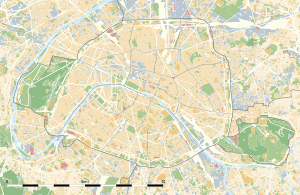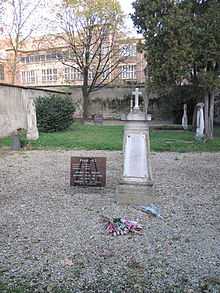Picpus Cemetery
|
Cemetery entrance next to chapel Notre-Dame-de-la-Paix | |
 Location within Paris | |
| Details | |
|---|---|
| Established | 13 June 1794 |
| Location | 35 rue de Picpus, Paris |
| Country |
|
| Coordinates | 48°50′38″N 2°24′00″E / 48.843889°N 2.4°E |
| Type | Private |
| Size | 2.1 hectares (5.2 acres) |
| Number of graves | unknown |
| Number of interments | 1,306 (two mass graves) |
| Find a Grave | Picpus Cemetery at Find a Grave |
Picpus Cemetery (French: Cimetière de Picpus) is the largest private cemetery in Paris, France, located in the 12th arrondissement. It was created from land seized from the convent of the Chanoinesses de St-Augustin, during the French Revolution. Just minutes away from where the guillotine was set up, it contains 1,306 victims executed between June 14 and 27 July 1794, during the height of the Reign of Terror. Today only descendents of those 1,306 victims are eligible to be buried at Picpus Cemetery.[1]
Picpus Cemetery is one of only two private cemeteries in Paris, the other being the old Cimetière des Juifs Portugais de Paris in the 19th arrondissement.
Picpus Cemetery is situated next to a small chapel, Notre-Dame-de-la-Paix ("Our Lady of Peace"), run by the Sisters of the Sacred Heart. The priests of the Congregation of the Sacred Hearts are referred to as "The Picpus Fathers" because of the order's origins on the street. It holds a small 15th-century sculpture of the Vierge de la Paix, reputed to have cured King Louis XIV of a serious illness on 16 August 1658.[2]
The cemetery is of particular interest to American visitors as it also holds the tomb of the Marquis de Lafayette (1757–1834), over which an American flag is always present.[3]
Location
The entrance to the cemetery is at 35 rue de Picpus in the 12th arrondissement. It can be visited in the afternoon every day except Monday, with hours usually from 2 pm to 6 pm (Admission: €3). The Chapel of Our Lady of Peace is located at the entrance of the cemetery. The nearest Paris metro stations are Nation and Picpus.
Reign of Terror

During the French Revolution, the guillotine was set up in the Place de la Nation, then called the Place du Trône Renversé. Between 13 June and 28 July, during the time known as the Reign of Terror, as many as 55 people per day were executed.
The Revolutionary Tribunal needed a quick but anonymous way to dispose of the bodies. The cemetery is only five minutes from the Place de la Nation.
A pit was dug at the end of the garden where the decapitated bodies were thrown in together, noblemen and nuns, grocers and soldiers, laborers and innkeepers. A second pit was dug when the first filled up.
The names of those buried in the two common pits, 1,306 men and women, are inscribed on the walls of the chapel. Of the 1,109 men, there were 108 nobles, 108 churchmen, 136 monastics (gens de robe), 178 military, and 579 commoners. There are 197 women buried there, with 51 from the nobility, 23 nuns and 123 commoners. The bloodshed stopped when Robespierre himself was beheaded, and the garden was closed off.
Among the women, 16 Carmelite nuns ranging in age from 29 to 78, were brought to the guillotine together, singing hymns as they were led to the scaffold, an incident commemorated in Poulenc's opera, Dialogues of the Carmelites. They were beatified in 1906 as the Martyrs of Compiègne.
Post-Revolution

In 1797, under the Directory, the land was secretly acquired by Princess Amalie Zephyrine of Salm-Kyrburg, whose brother, Frederick III, Prince of Salm-Kyrburg, was buried in one of the common graves. In 1803, when Napoleon was First Consul, a group of family members of aristocrats bought up the rest of the land, and built a second cemetery next to the common graves.
In a meeting held in 1802, underwriters designated 11 of them to form a committee:
- Madame Montagu, née L. D. de Noailles, President
- Maurice de Montmorency
- Mr. Aimard de Nicolaï
- Madame Rebours, née Barville
- Madame Freteau widow, née Moreau
- Madame de La Fayette, née Adrienne de Noailles
- Madame Titon, née Benterot
- Madame Faudoas, née de Bernières
- Madame Charton, née Chauchat
- Philippe de Noailles de Poix
- Theodule M. de Grammont
Many of these noble families still use the cemetery as a place of burial.
Marquis de Lafayette

General Lafayette, who died a natural death at age 76 in 1834, is buried here, and an American flag always flies over his grave, courtesy of the local chapter of the Daughters of the American Revolution (DAR).[4] He is buried next to his wife, Adrienne de La Fayette, whose sister and mother were among those beheaded and thrown into the common pit.
On 4 July 1917, U.S. Army Colonel Charles E. Stanton during World War I. He visited the general's tomb and left an American flag, uttering the famous phrase, "Lafayette, we are here."
| “ | America has joined forces with the Allied Powers, and what we have of blood and treasure are yours. Therefore it is that with loving pride we drape the colors in tribute of respect to this citizen of your great republic. And here and now, in the presence of the illustrious dead, we pledge our hearts and our honor in carrying this war to a successful issue. Lafayette, we are here. | ” |
| —U.S. Army Colonel Charles E. Stanton[5] | ||
Every Fourth of July, members of the DAR, the Society of the Cincinnati and U.S. embassy officials gather at Lafayette's tomb for a celebration.[6]
Holocaust
In 1852, financier James Mayer de Rothschild built a hospital and hospice next door to the cemetery, at 76 rue de Picpus. Initially intended to treat Jewish patients, Hôpital Rothschild was transformed into a general hospital open to all during World War I.[7]
During the Nazi occupation of Paris during World War II, French, Polish, and German Jews were rounded up and sent to the Drancy internment camp north of Paris.[8] Pregnant women, the seriously ill and children were sent to the Rothschild Hospital, which became an extension of the Drancy camp, under full guard and surrounded by barbed wire.[7]
Under the collusion of Vichy France with Nazi Germany, its patients who survived their illnesses were all deported to concentration camps. Of the 61,000 from Drancy sent to the camps, only 1,542 remained alive when the Allied forces liberated the camps in 1944.[9] There is a special plaque dedicated to their memory at Picpus Cemetery.
Notable burials at Picpus Cemetery
- 1,306 victims of the terror between June 14 and 27 July 1794
- Gilbert du Motier, marquis de Lafayette, hero of the French and American revolutions (6 September 1757 – 20 May 1834)
- André Chénier, guillotined on 7 Thermidor Year II
- Richard Mique, architect of the Hameau de la reine at the Palace of Versailles, guillotined 8 July 1794
- Aimé Picquet du Boisguy, chouan general
- The Carmelite nuns, Martyrs of Compiègne, guillotined and buried in one of two mass graves
- Jean-Antoine Roucher (1745–1794), poet, recipient of Gabelle, guillotined, 7 Thermidor Year II (see the engraving The last wagon)
- Alexandre de Beauharnais, lover of Princess Amalie Zephyrine of Salm-Kyrburg, guillotined, 5 Thermidor, Year II (23 July 1794)
- Frederick III, Prince of Salm-Kyrburg, German prince, colonel of the German troops, the battalion commander of the Fontaine-Grenelle, brother-in-law of the prince Anton Aloys, Prince of Hohenzollern-Sigmaringen and brother of Princess Amalie Zephyrine, guillotined 6 messidor, Year II (23 July 1794).
- Marguerite Louise d'Orléans, Grand Duchess of Tuscany (1645–1721)
- "G. Lenotre" (nom-de-plume of Louis Léon Théodore Gosselin, 1855–1935), French academician, historian and author of many works about the French Revolution, including Jardin de Picpus".
External links
| Wikimedia Commons has media related to Cimetière de Picpus. |
- Complete list of the 1,306 victims of the Terror buried at Picpus
- Nobility buried at Picpus after the French Revolution
- Picpus, walled garden of memory, Northwestern University Documentary and Digital Archive
References
- ↑ Marie-Christine Pénin. "Cimetière de Picpus: cimetière révolutionnaire" (in French). Tombes & Sepultures. Retrieved 16 January 2015.
- ↑ Alfred Fierro (1988). Vie et histoire du XIIe arrondissement (in French). ISBN 978-2903118334.
- ↑ "Cimetière de Picpus" (in French). Office du Tourisme et des Congrès de Paris. Retrieved 16 January 2015.
- ↑ "Picpus Cemetery". pariscemteries.com. Retrieved 16 January 2015.
- ↑ Charles E. Stanton Quotations, Biography
- ↑ "France et Etats-Unis: Lieux historiques" (in French). Embassy of the United States, Paris. Retrieved 16 January 2015.
- ↑ 7.0 7.1 Anne Landau. "The Rothschild Hospital". Northwestern University. Retrieved 16 January 2015.
- ↑ "This Month in Holocaust History - December - Drancy". Yad Vashem. Retrieved 16 January 2015.
- ↑ "Related Resources - Drancy". Yad Vashem. Retrieved 16 January 2015.